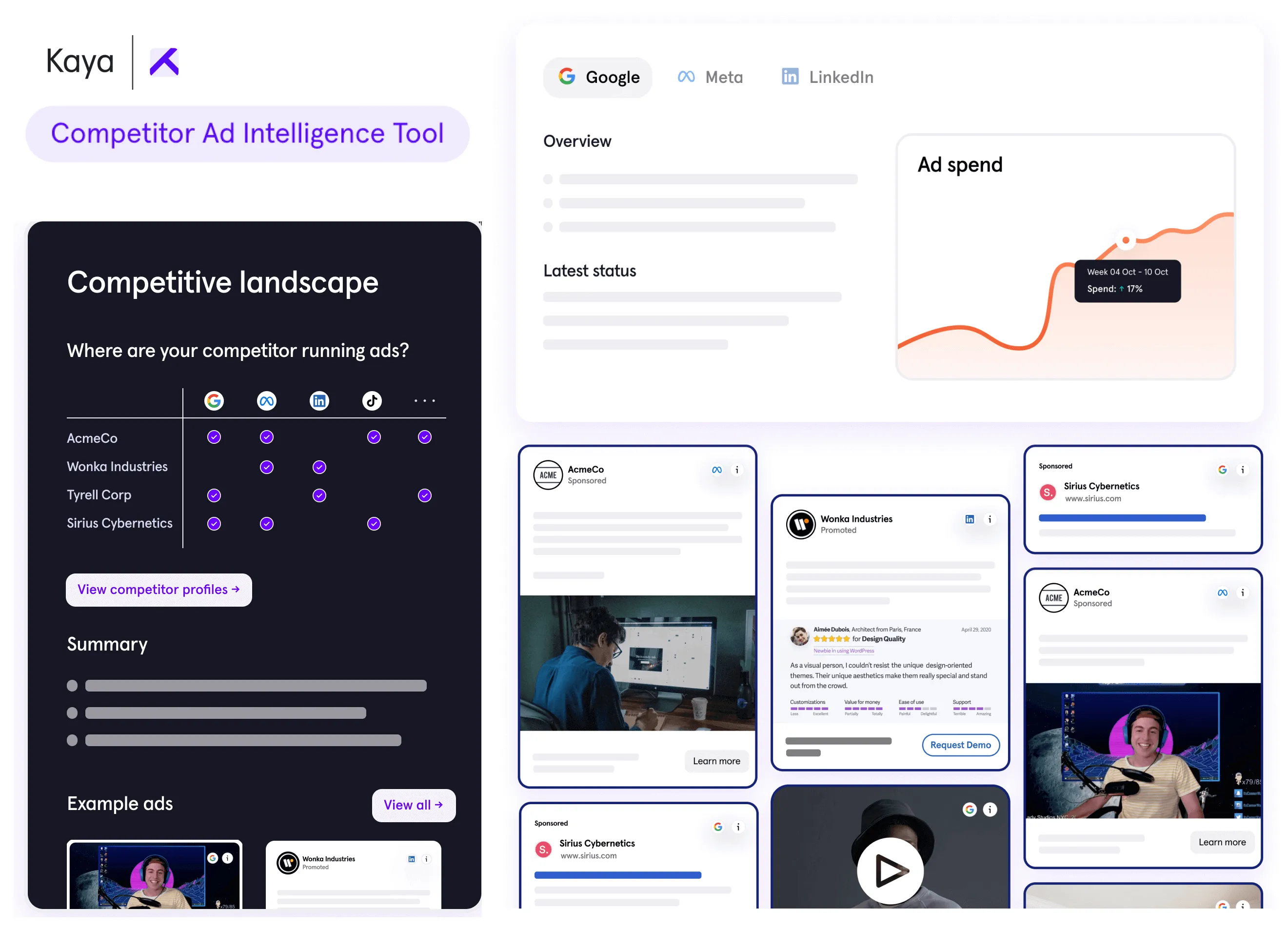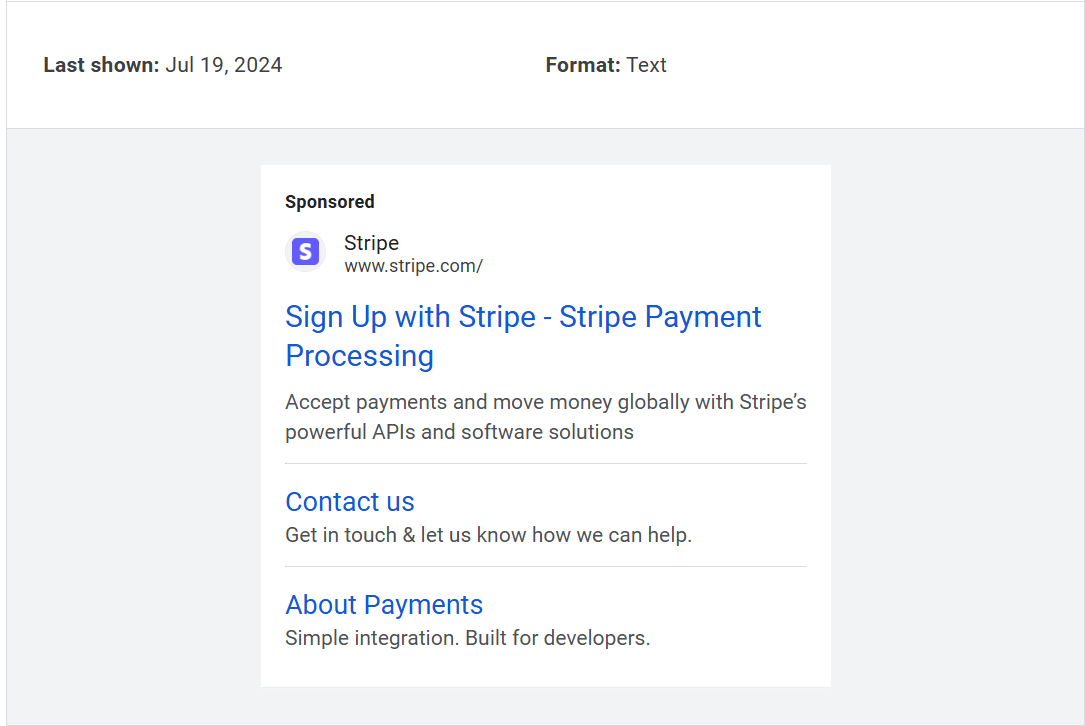Whether you're in tech, retail, or any other niche, understanding how competitors structure their ads, what messages they convey, and which channels they use can provide valuable insights. A competitor ads analysis allows you to identify new opportunities and gaps that you can use to your advantage.
In this article, we'll be covering below to help you analyze competitor ads like an experienced marketer:
- Understanding competitor ads analysis
- Types of competitor ads to analyze and their relevance to startups
- Tools and methods to find competitor ads
- Key elements in competitor ads analysis
- Best practices for ongoing competitor ads analysis
- How to use competitor ad data effectively
Understanding competitor ads analysis
What are competitor ads?
Competitor ads are paid marketing campaigns run by companies offering similar products or services to yours. These can appear on platforms like Google, Facebook, LinkedIn, or TikTok. Analyzing them helps you understand their messaging, positioning, and ad strategy.
What is an example of a competitor ad?
If you're a fintech startup, a competitor ad could be a Google ad from Brex that says: “Get up to 10x higher limits with no personal guarantee – Apply now.” You can view such ads in the Google Ads Transparency Center or Meta Ad Library.
How do I find my competitors' ads?
You can manually check public ad libraries:
- Google Ads Transparency Center
- Meta Ads Library
- LinkedIn Ad Library
- TikTok Creative Center
Or use tools like Kaya’s Competitor Ad Intelligence to see ad creatives, spend estimates, and targeting data, all in one place.
What is competitor analysis in marketing?
Competitor analysis is the process of identifying, monitoring, and evaluating your business rivals to understand their strengths, weaknesses, marketing strategies, and positioning. In digital advertising, this means analyzing competitors’ ads, targeting, channels, and messaging to uncover insights that can improve your own campaigns.
What is competitor ad analysis?
Competitor ads analysis involves examining your competitors' advertising strategies to understand their strengths and weaknesses. It helps you learn from their successes and avoid their mistakes, making your marketing efforts more refined and cost-efficient.
Types of competitor ads to analyze and their relevance to startups
You can focus on these common ad types for your competitor ads analysis and fine-tune your strategy from there.
- PPC (pay-per-click) ads: PPC ads drive immediate traffic to your website, which makes them suitable for startups that need fast results. Analyzing competitors' PPC ads allows you to identify the keywords driving traffic and conversions.
- Display ads: Display ads are effective for building brand awareness on a limited budget. Studying competitors' display ads allows you to learn effective design and messaging strategies that you can incorporate into your ads.
- Social media ads: About 62% of the world's population use social media, with average usage time being 2 hours and 7 minutes daily. Social media allows you to target a broader audience and build a community of brand loyalists. Analyzing competitors' social ads helps uncover insights into their copy, content format, targeting, and messaging.
Tools and methods to find competitor ads analysis
Using the right tools for competitor ads analysis allows you to automate the process and save time. Here are some effective tools and methods:
- Kaya
- SEMrush
- SpyFu
- Facebook Ad Library
- Google Transparency Center
- LinkedIn Ad Library
Ad libraries
- Facebook Ad Library: This free tool allows you to view all active ads from any Facebook page. It's a great starting point for monitoring competitors' social media campaigns.
- Google Ads Transparency Report: This tool provides insights into ads running across Google’s network.
- LinkedIn Ad Library: The ad library helps you find and understand various ads on LinkedIn, enabling you to find what works and augment your advertising strategies. It is suitable for B2B startups.
Competitive analysis tools

Kaya's Competitor Ad Intelligence Tool shows you where your competitors are running ads; how much they're spending; which ad formats are working for them.
Kaya: Competitor Ad Intelligence Tool consolidates ad data from ad libraries like Google Transparency Center and Meta Ads Library to analyze key information, such as:
- Keywords competitors are bidding on
- Ad relevance and potential for clients' campaigns
- Suitable keywords to expand reach and drive conversions
- Competitors' ad types, messaging, and offers
- Longest-running ads to identify successful themes and strategies
The two-pronged approach of Kaya’s Competitor Ad Intelligence Tool allows you to improve your sign-ups and overcome creative blocks.
SEMrush: SEMrush provides comprehensive competitor ad analysis covering PPC, display ads, and more. It helps startups understand where competitors are investing their ad budgets and how effective those investments are.
SpyFu: SpyFu allows you to see every keyword competitors have bought on Google, every ad variation, and how they performed.
Manual searches and organic monitoring
Although they may take a bit more time than competitor ad analysis tools, manual searches are a cheap and realistic way to find competitor ads and engage in discussions with industry experts. Here are some manual search strategies for competitor ad analysis.
- Search engines: Regularly search for industry-related keywords to see which competitors' ads appear. Why? This method helps identify active PPC campaigns and the messaging used.
- Social media platforms: Follow competitors on social media and observe their ad campaigns. Engage with their content to witness their retargeting strategies firsthand.
- Industry forums and communities: Founders and small business owners often use platforms like Quora and Reddit to discuss ad campaign ideas, what works, and what they could be doing better. Engaging with online communities provides real-time feedback on ads.
Key elements to analyze in competitor ads
Once you find ads on different platforms, you want to zoom in and extract helpful insights quickly. Here are the ad elements to analyze in your competitor’s ads.
Ad copy and messaging
An effective ad copy should be compelling, clear, concise, and relatable, touching on the audience's needs and desires. It should address a specific audience and highlight the features and benefits of the product.
For instance, Stripe, a fintech startup, uses ad copy emphasizing ease of use and smooth integration, targeting developers with phrases like 'built for developers.' The messaging is clear, and there’s no ambiguity. The ad copy also communicates the USP, positioning Stripe as the solution for seamless global payments processing.

Stripe's ad copy calls out its target audience with phrase like 'built for developers' and its USP as the solution for seamless global payments processing.
Call-to-Action (CTA) strategies
A strong CTA drives user action. CTAs also have several dimensions you can analyze aside from the text, such as their position in the ad, their customization, and the styling. Customized CTAs convert 42% more visitors, while Copyblogger increased its clickthrough by 45% after switching to button-shaped CTAs.
In the cited example, Stripe includes two CTAs. One in the first line and the other in the second line of the copy. The first, ‘Sign up with Stripe' targets audiences who are ready to use the service. The second ‘Contact us’ targets those who need more information.
You also want to check if it is customized and contains powerful words, such as ‘Get started,’ ‘Join now,’ ‘Sign up for free,’ etc. DoorDash uses CTAs like 'Order now,' and ‘Become a restaurant partner’. Although the CTAs target different audiences, they are both direct and lead the audience to take the next action.
Targeting and audience
Your competitors are likely targeting the same audience demographic as you. They may be doing better by going after an audience segment or locations that you may not have considered. They may also be retargeting to entice previous website visitors. Analyzing their target audience lets you see that. DoorDash emphasizes its home delivery, targeting people looking for convenient e-commerce.
Ad placement and timing
Where and when ads are placed can impact performance. The type of product and target audience could also impact when and where competitors place their ads. Some timing may signal seasonality, new market opportunities, a product launch, or a strategic shift.
A fashion brand targeting teenagers and young adults would do well on a platform like TikTok. Around 68% of TikTokers are between 17 and 24, making it the most popular platform for the younger generation. HubSpot mainly advertises on LinkedIn because their products (CRM) target B2B companies and marketing professionals.
Visual elements (images, videos)
Visuals are crucial for capturing attention and conveying a message quickly. Consider visual elements in your competitor’s ads, like logos and ad images within search ads. These elements make ads memorable. Check the imagery, fonts, colors, and design aesthetics used in your competitor's ad visuals. Consider how these elements tie into the overall message and appeal of the ad. Consider LinkedIn’s display ad.
There’s a real pain in hiring—the cost and time. They address that with the message, insert a happy man, which denotes an ideal candidate and invite them to post a job for free. It balances messaging with visuals and CTA.

LinkedIn's display ads focus on addressing recruiters' pain points: the need for faster hiring and cost-effective recruitment.
Ad types
Choosing the right ad format helps you communicate in a way that resonates with your target audience. If you’re a healthy food brand, text ads will not cut it. You want to use videos and also make them conversational, like giving your audience the chance to try out the recipes at home.
- Conversational ads: Allows you to engage the users and enable feedback. It makes your brand more approachable and is useful when you want to extract information directly from your audience. They are effective for first-time audiences and retargeting campaigns.
- Text ads: They are effective for brand awareness and informing users who are actively looking for specific information.
- Other types, such as video ads, carousel ads, and interactive ads, can be used based on the campaign objectives and audience preferences. For instance, Stripe has a video ad to demonstrate its product's features and benefits for iPhone users. It’s a 13-second ad with the tagline 'Tap to pay on iPhone'.
Best practices for ongoing competitor ads analysis
No matter the ad type or tool, competitor ad analysis can be ineffective if not properly done. Here are best practices to help you extract the most impactful insights from your ad analysis.
Conduct detailed keyword research
Keyword research reveals high-performing keywords used by your competitors. It also gives you an insight into low-competition keywords that you can target.
On the one hand, you have keywords that you can compete on, and on the other hand, you can quickly assert dominance in the low-competition keywords before your competitors catch on. Not conducting keyword research will lead to low ad relevance and poor targeting, which results in higher costs per acquisition (CPA) and low conversion rates.
Conduct a SWOT analysis
A SWOT analysis allows you to itemize the findings from the ad analysis. It offers a clear view of what works for your competitor’s ad strategy and the gaps you can exploit. It also shows you the threats, which are factors beyond your control. For example, you could identify platforms that are prone to ad blockers; if you run ads on such platforms, you risk losing your investment.
Benchmark against your competitors using the competitive positioning framework
For a more in-depth analysis, consider looking into this Competitive Positioning Framework template. Use this to compare against your competitors and identify your solution/benefit statements, core differentiators, category(s), and market position.
Remember, your competitors may be distinguished brands, emerging disruptors, as well as adjacent solutions. Explore brands that would complement your product or services. Brands that your customers trust and/or use together with your product may suggest opportunities for collaboration and integration.
Track ad frequency and placement
Monitor the frequency and channels where your competitors place their ads. An increase in ad frequency or a shift in placement may indicate a higher ad budget commitment, seasonal promotions, or a new product launch. A high ad frequency may also suggest your competitors are aggressively targeting a new audience or engaging in retargeting to maximize conversion opportunities.
Use alerts to monitor competitor ads
You can use Google Alerts to receive notifications about changes in a competitor’s Google ad activities. Alerts allow you to keep up with shifts in your competitors' ad strategies, such as new campaigns or changes in their messaging.
For instance, if a competitor stops running ads on a keyword, it is likely that such a keyword has become ineffective. Without alerts, you are unaware of that and continue to invest in those keywords, which could deplete your ad budget. Tracking competitor ads also allows you to stay agile and swiftly react to changes in your competitor’s ad strategies.
A/B testing based on competitor insights
A/B testing involves comparing two versions of an ad to see which performs better. Use insights from competitor ads to inform your A/B tests. If a competitor's ad with a specific CTA performs well, you can A/B tests with variations, yours or that of another high-performing competitor.
For instance, if competitor A uses 'Sign Up Now' and achieves high conversions, test variations like 'Join Us Today' or 'Get Started’ in your ads. A/B tests work well because they are a data-driven approach that allows you to compare two options to see which works better.
How to use competitor ad data effectively
Following the above best practices allows you to collect data-driven insights. But after that, you need to act. Here are practical tips on using the data from your competitor’s ad analysis.
Identifying trends and patterns: Following the insights from your competitor’s ad analysis, you can identify industry and ad platform trends. For instance, if you notice competitors focusing on holiday-themed ads in November, it indicates that seasonal campaigns are effective.
Benchmarking against your own ads: Compare their performance metrics against yours. Such side-by-side comparisons let you know how you stack up against your competitors. If you’re falling behind, you can take another look at their ad activities or A/B test their strategies against yours, from which you can improve based on the results.
Inspiration for new creative approaches: Competitor ads can inspire new creative ideas. Study their ad designs, messaging, and formats to spark creativity in your campaigns. If a competitor uses engaging video ads that perform well, consider incorporating video into your ad strategy to enhance engagement.
Adjusting your targeting and strategy: If you find out that your competitors are targeting demographics or platforms you have not considered, you can then readjust your ads to target that demographic or a subsection of it that fits closer to your product.
Enhancing your ad spend efficiency: Identify which ad types and placements yield the best ROI, and consider shifting resources to that. Also, monitor when your competitors stop running ads, as that could be a sign that the target keywords are no longer effective. It could also be that advertising on such platforms has become redundant. In both cases, you need to pull the plugs on your ads and focus on the better-performing ones.
Case study: How Kaya uses competitive ad analysis to deliver value
Kaya uses competitor ad analysis to deliver impactful ad campaigns and ROI improvements for its clients. At Kaya, AI is fully integrated into our processes, easing marketing decision-making.
Kaya focuses on two key areas for competitor analysis, using the AI-driven Competitor Ad Intelligence Tool to consolidate ad data from ad libraries like Google Transparency Center and Meta ads library and analyze for information below.
For Google Ads, we look into the competitors’ keyword strategies, including their ad spend. By doing so, we've expanded our B2B tech startup clients' reach and significantly increased their sign-ups.
When it comes to Meta Ads, we analyze competitors' ad types, messaging, and offers. By studying their longest-running ads, we uncover successful themes and target audience insights. This helped us overcome a creative block for a B2C YC-backed startup client, leading to fresh, engaging ad content.
By combining AI-powered analysis with human expertise, Kaya delivers impactful ad campaigns that drive results. Our data-driven approach ensures that every marketing decision is informed, strategic, and tailored to each client's unique needs.
FAQ
What is competitor ad copy analysis?
What tools are best for finding competitor ads?
How often should I analyze competitor ads?
What are the key metrics to look at in competitor ads?
What is an example of a competitor campaign?
Final thoughts
Competitor ads analysis gives you a clear idea of what competitors are doing right or wrong. However, many startups do not do it the right way. By following the outlined best practices, you can extract and act on the right data-driven insights.


